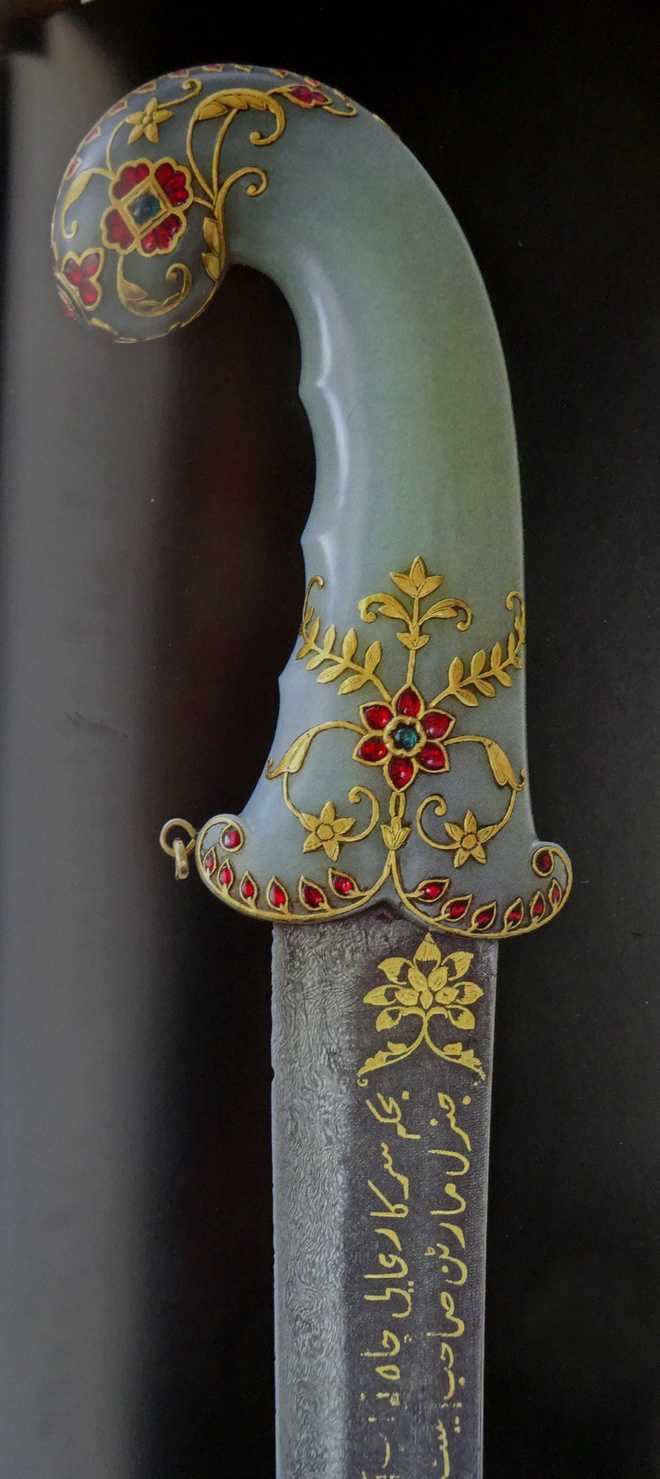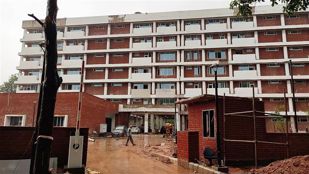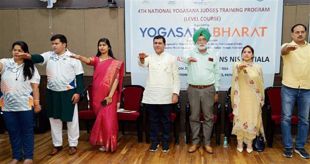
Magic in detail: Sword presented to General Claude Martin by the Nawab.
BN Goswamy
Asaf al-Daula (r. 1775-1797) revelled in a life of courtly splendour and strove to surpass his rival potentates, the Nizam Ali Khan of Hyderabad (r. 1762-1803) and Tipu Sultan of Mysore (r. 1783-1799). He spent lavish sums on the luxuries of royalty and built imposing palatial and religious architecture to proclaim the magnificence of his dynasty. Grand palaces, mosques, and mausoleums were erected, inspired by the architectural marvels of the great Mughals but given a European flavour through hybrid flourishes and embellishment on the interior with numerous European glass chandeliers…. — Stephen Markel
Yahi tashweesh shab-o roz hai
Bangaaley mein
Lucknow phir kabhi dikhlaaye
muqaddar mera
[By day and by night this thought haunts me in my captivity: Will the heavens grant me just one glimpse of my Lucknow again?] — Wajid Ali Shah
It has been some 10 years that at the Los Angeles County Museum of Art a fine exhibition on Lucknow was put up under the title, India’s Fabled City: the Art of Courtly Lucknow. But even now, one dips into the volume from time to time, especially when one is looking for some specific information or insight. In my effort recently to locate the source of a delicate silver object in a different museum, I found myself going back to Stephen Markel’s essay in the volume on the ‘Luxury Arts of Lucknow’. Needless to say, I landed, nearly exactly, upon the answer I was seeking. In addition, I learnt that champlevé is enamelwork in which hollows made in a metal surface are filled with coloured enamels, and basse-taille is a piece of jewellery in which transparent enamels are fused over a background carved in low relief!
Invariably, when it comes to that ‘blaze of wealth and magnificence’ — Rev. William Tennent’s bedazzled description of what he saw at the Avadh court — what surfaces in the mind specially is the period of Nawab Asaf al-Daulah. Under him, the capital had been moved from Faizabad to Lucknow; great architectural projects were taken in hand and completed; a ‘new generation of artistic performers and courtiers’ had come to settle in the city; music and dance were in the air everywhere; and at least two European adventurers — the Frenchman, General Claude Martin, and the Swiss engineer, Col. Antoine-Louis Polier — had made the place their home, enriching the city and the kingdom with their talents. Abdul Halim Sharar who wrote that delicious memoir of Lucknow in Urdu — Guzashta Lakhnau, Hindustan mein mashriqi tamaddan ka aakhri namoona [Lucknow: The Last Phase of an Oriental Culture] — evoked the flavour of the period with incomparable refinement, speaking of the Lakhnavi accents and diction, of men and manners, customs and conventions, costumes and fashion, social protocols and courtly etiquette. A great deal has been written on the Lucknow of old, and a great deal questioned. In all this welter of information, two things — questions one might term them — stand out in my mind: at least at the moment. One, was there a conscious attempt at the Nawab Wazir’s court of Lucknow to fashion a new identity for itself: in other words, not to be seen simply as a successor to the court of the Mughals which had begun to crack and break in the 18th century, but as a cultural hub that had a voice of its own, a distinctive vision? And, two, how did the Nawabs of Lucknow respond to the architectural undertakings of a complete outsider like Claude Martin who was raising building after building within their domains?
There are no easy answers. With regard to the first, however, it can be said that a visual language seemed to be consciously aimed at: inspired by ideas taken from different sources but eventually recognisable as Lakhnavi. Stephen Markel gives a fine example, of the kind that at first might go unnoticed because so small, but eventually meaningful. A ‘codified floral imagery’ was developed here, a ‘distinctive decoration’. One cannot go into details here, even though examples can be cited from enamelled silverware and delicately fashioned glass vessels. But — to sum it up in his words — as against the Mughal preference for a single flower, like the poppy, in the language of design, “the vibrant, flowering floral imagery of Lucknow transmuted the orchestrated severity of Mughal flowering plants”. Stylised irises, lilies, poppies, roses, rosettes, and other blossoms both real and imaginary began here “to burst into bloom on scrolling vines”. Integrated into those arrangements was what emerged as a recurrent, almost obsessive, motif: a pair of fish, generally arranged head-to-head with their curved bodies forming a circle. Whether the motif came out of the rarely granted and highly regarded honour of Perso-Mughal origin — the Mahi Maratib, meaning ‘the Rank of the Fish’ — is something that has been debated. But the pair of fish was to be seen in Lucknow everywhere: in architectural decoration, on jewellery and silverware, in embroideries, on weaponry and coats of arms.
And then, there in Lucknow, was the presence of Claude Martin, the General who served at one time in the French forces but moved later to join the English East India Company, and settled in Lucknow with the approval of his British masters. A person of uncommon talent and disposition, it would seem, Claude Martin was a builder, a collector, a connoisseur, and philanthrope, all rolled into one. In and around Lucknow, he kept building but everywhere almost in partnership with Nawab Asaf al-Doulah who revelled in these dreamy enterprises. Kothi Hayat Baksh, Farhat Baksh,Asafi Kothi, Bibiapur, Barowen: the very names of the buildings suggest this. The one building, the most distinguished of all that Claude-Martin built, that bore a European name, however, was Constantia. The remarkable structure — ‘a blend of various styles; with Mogul cupolas at the corners and figures of Greek gods and goddesses atop the ramparts and the lions which are symbolic of the East India Company’ — is at once a mausoleum of its builder and a distinguished school. The Nawabs recognised this. For them this European was “Most excellent in government, Sword of the Realm, Supreme amongst Knights, General Claude Martin the Brave, Courageous in War.”



























